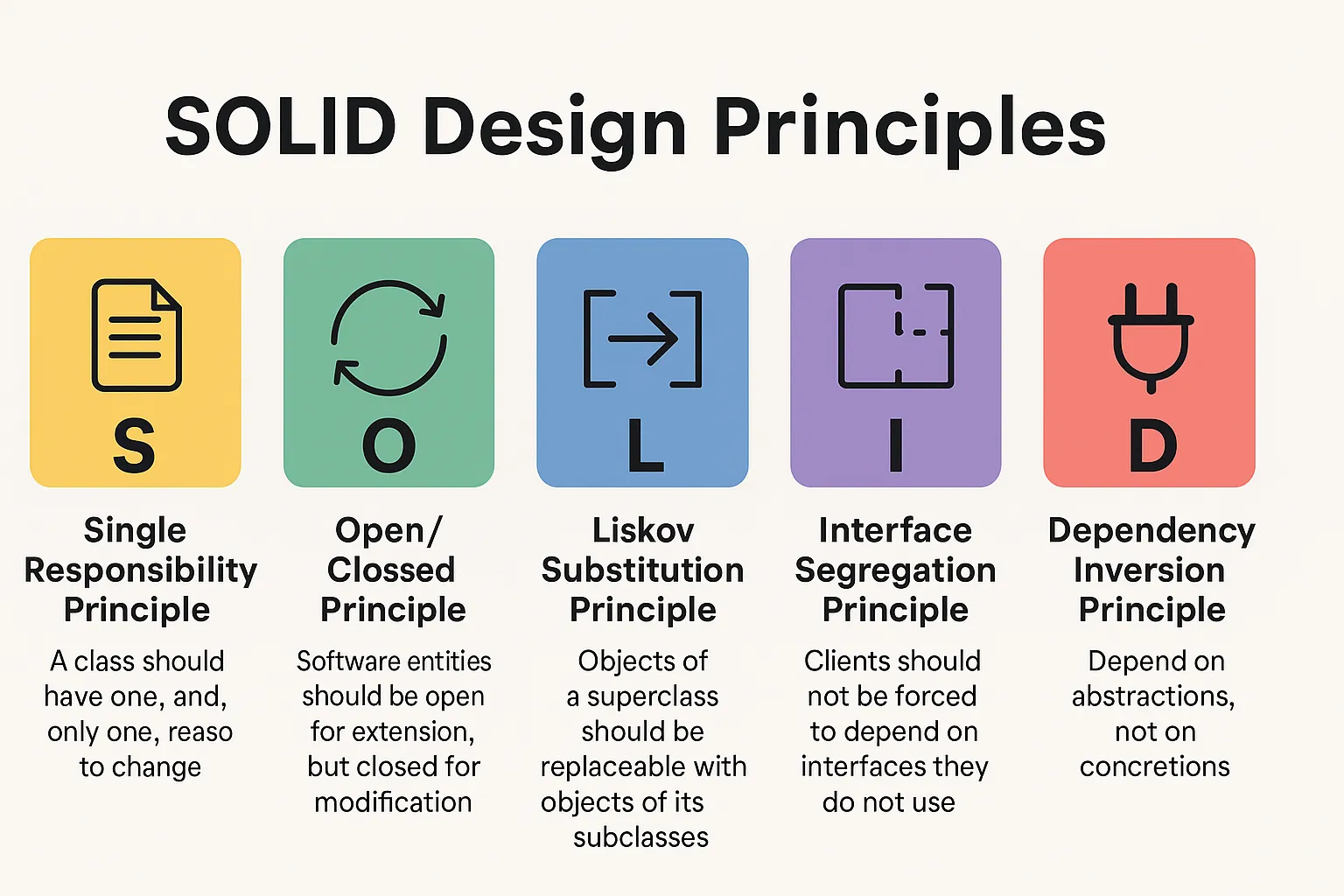💡 Why Clean Design Matters
When software scales, complexity creeps in—not as loud chaos, but as subtle friction. Clean design isn’t just a matter of elegance; it’s a survival strategy. It empowers teams to collaborate smoothly, extend features confidently, and resolve bugs swiftly.
Imagine a skyscraper. You don’t see the structural steel and load-distribution systems behind the polished glass—but they’re what keep everything standing tall through storms and time. SOLID principles are like that invisible engineering for your codebase: they quietly hold everything together, preventing collapse as new floors (features) are added.
In this post, we’ll explore each of the five SOLID pillars and see how they reinforce architecture from the inside out.
SOLID Principles
The SOLID principles are a set of design guidelines that help developers build maintainable, extensible, and robust software. They are especially important in object-oriented programming. SOLID stands for:
- S - Single Responsibility Principle (SRP)
- O - Open/Closed Principle (OCP)
- L - Liskov Substitution Principle (LSP)
- I - Interface Segregation Principle (ISP)
- D - Dependency Inversion Principle (DIP)
graph LR
SOLID((SOLID Principles))
SRP[Single Responsibility Principle]
OCP[Open/Closed Principle]
LSP[Liskov Substitution Principle]
ISP[Interface Segregation Principle]
DIP[Dependency Inversion Principle]
SOLID --> SRP
SOLID --> OCP
SOLID --> LSP
SOLID --> ISP
SOLID --> DIP
SRP --> Maintainability[Better maintainability]
OCP --> Extensibility[Easy to add features]
LSP --> Reliability[Safe substitutions]
ISP --> Flexibility[Focused, modular interfaces]
DIP --> Testability[Decoupled, test-friendly design]
Single Responsibility Principle (SRP)
A class should have only one reason to change, meaning it should only have one job. This makes your code easier to maintain and test. For example, if a class handles both user data and reporting, changes in reporting requirements could affect user data logic, leading to bugs.
// Bad Example
class User {
void SaveToDatabase() { /* ... */ }
void GenerateReport() { /* ... */ }
}
// Good Example
class User { /* ... */ }
class UserRepository {
void Save(User user) { /* ... */ }
}
class ReportGenerator {
void Generate(User user) { /* ... */ }
}
Open/Closed Principle (OCP)
Software entities should be open for extension, but closed for modification. This means you should be able to add new functionality without changing existing code, reducing the risk of introducing bugs. Use interfaces or abstract classes to achieve this.
// Bad Example
class Discount {
double GetDiscount(string type) {
if (type == "Student") return 0.2;
else if (type == "Senior") return 0.3;
return 0;
}
}
// Good Example
interface IDiscount {
double GetDiscount();
}
class StudentDiscount : IDiscount {
public double GetDiscount() => 0.2;
}
class SeniorDiscount : IDiscount {
public double GetDiscount() => 0.3;
}
Liskov Substitution Principle (LSP)
Subtypes must be substitutable for their base types without altering the correctness of the program. If a subclass cannot stand in for its parent, it breaks the contract and can cause runtime errors. Design your inheritance hierarchies carefully.
// Bad Example
class Bird {
public virtual void Fly() { }
}
class Ostrich : Bird {
public override void Fly() { throw new Exception("Can't fly"); }
}
// Good Example
class Bird { }
class FlyingBird : Bird {
public void Fly() { /* ... */ }
}
class Ostrich : Bird { /* ... */ }
Interface Segregation Principle (ISP)
Clients should not be forced to depend on interfaces they do not use. Split large interfaces into smaller, more specific ones so classes only implement what they need. This keeps your code flexible and easier to maintain.
// Bad Example
interface IWorker {
void Work();
void Eat();
}
class Robot : IWorker {
public void Work() { /* ... */ }
public void Eat() { throw new NotImplementedException(); }
}
// Good Example
interface IWorkable {
void Work();
}
interface IEatable {
void Eat();
}
class Robot : IWorkable {
public void Work() { /* ... */ }
}
Dependency Inversion Principle (DIP)
High-level modules should not depend on low-level modules. Both should depend on abstractions. This makes your code more flexible and easier to test, as you can swap implementations without changing the high-level logic.
// Bad Example
class LightBulb {
public void TurnOn() { /* ... */ }
}
class Switch {
private LightBulb bulb = new LightBulb();
public void Operate() { bulb.TurnOn(); }
}
// Good Example
interface IDevice {
void TurnOn();
}
class LightBulb : IDevice {
public void TurnOn() { /* ... */ }
}
class Switch {
private IDevice device;
public Switch(IDevice device) { this.device = device; }
public void Operate() { device.TurnOn(); }
}
🐞 Real-World Scenarios: When SOLID Saved the Day
🔹 SRP Breakdown – Tangled Reporting in CRM
Our CRM's UserManager class was managing user data and generating monthly reports. When the marketing team requested a change to the report format, it inadvertently broke the save-to-database logic—because both responsibilities lived in the same class.
Solution: We split responsibilities into UserRepository and ReportGenerator. Bugs vanished, features were added faster, and the code was much easier to test.
🔸 OCP Misstep – Discount Logic Spiral
Originally, we had a DiscountCalculator class with a big switch statement for each user type. Each time a new discount was introduced (student, senior, veteran), we had to modify existing code—leading to merge conflicts and accidental overwrites.
Solution: We refactored using the OCP principle: created an IDiscount interface and separate classes for each discount type. Now we add new logic without touching the existing code.
🔹 DIP Violation – Hardwired Devices in Home Automation
The Switch class in our IoT system was hardcoded to use LightBulb. When we needed to support a Fan and a SmartHeater, the ripple effect caused changes in multiple modules.
Solution: We introduced the IDevice interface and inverted dependencies so that the Switch worked with any device abstraction. Our system became modular and easily expandable.
🔗 Related Design Principles and Patterns
Now that you've explored SOLID principles, here are a few other foundational concepts that complement your design architecture:
- DRY (Don't Repeat Yourself): Reduces redundancy, leading to cleaner code and fewer bugs.
- KISS (Keep It Simple, Stupid): Encourages simplicity over complexity, making your codebase easier to understand and modify.
Looking to go deeper into real-world applications? Check out these design patterns that extend SOLID principles:
- 👁️ Observer Pattern – Useful for event-driven systems and UI components that react to state changes.
- 🧠 Strategy Pattern – Allows you to define a family of algorithms and make them interchangeable.
- 🎮 Command Pattern – Great for encapsulating actions as objects, often used in undo/redo functionality.
These patterns are explored in-depth with diagrams and code examples—perfect for the curious developer looking to level up their architecture toolkit.
Test your Understanding.
🛠️ Conclusion: Building Resilient Software with SOLID
The SOLID principles are not just theoretical concepts; they are practical tools that help you build software that can grow and adapt without breaking. By adhering to these principles, you create a codebase that is easier to maintain, extend, and test.
Remember, clean design is like a well-engineered foundation for your skyscraper. It may not be visible at first glance, but it’s what allows your software to stand tall and resilient against the storms of change.

